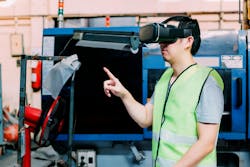Research Shows VR Can Foster Proactive Safety Culture
In a recent article, "Exploring the effectiveness of virtual reality-based training for sustainable health and occupational safety in Industry 4.0", the authors focus on how VR-based training can enhance the sustainability of occupational safety for industrial workers, thereby reducing industrial accidents and human errors.
The authors involved 200 participants in a quasi-experiment, with participants divided into two groups: intervention and control. The effectiveness of VR-based training was judged based on participants’ self-efficacy toward leadership support, training resources, and communication channels.
Each VR training session lasted 45 minutes, and a total of three sessions were conducted over one week. The intervention group participants underwent VR training on several OSH procedures central to their work. The training used a realistic, life-like approach to safety education, which helped participants enhance their safety awareness and attitudes toward risk in the workplace.
The control group received no VR training whatsoever; they did not require additional intervention beyond regular job activities and occupational safety measures.
The VR training included the following scenarios:
Emergency Response Simulation: Participants were placed in a virtual environment where they had to respond to simulated emergencies, including fires and chemical spills.
Hazard Identification: Participants walked through a virtual factory and identified potential safety hazards, including faulty equipment and unsafe working conditions.
Decision-Making under Pressure: In this scenario, participants were required to make quick decisions in high-pressure situations, such as responding to accidents or malfunctions.
The participants in both groups completed the same questions, assessing changes in their safety knowledge, risk identification capabilities, attitudes toward safety, and awareness after the VR training. The goal was to identify the changes resulting from the training and determine if VR training effectively promotes the OHS outcomes.
The Results
The results showed that both groups substantially improved the training and educational outcomes associated with VR. The authors note that these results support existing studies that demonstrate the effectiveness of VR technology as a tool for learning and retention. Also, learning new information using VR-based training is more effective.
The authors made the following concluding remarks.
VR training is likely beneficial for work and safety issues because it immerses trainees in realistic contexts, allowing them to practice and improve their skills. Training programs must incorporate VR elements to provide a realistic setting and motivate workers to progress. Furthermore, the sustainability goals will be achieved through these research results, which contribute to reducing workplace injuries and their associated costs while promoting a desire to grow, a necessary condition for sustained achievement in Industry 4.0 settings.
About the Author
Adrienne Selko
Senior Editor
Email [email protected]
Adrienne Selko is also the senior editor at Material Handling and Logistics and is a former editor of IndustryWeek.

